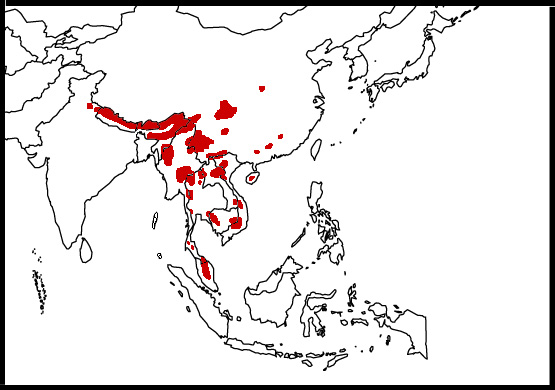Alternative name: Blue-winged Siva
- Actinodura cyanouroptera
Minla cyanouroptera, Siva cyanouroptera
Identification
With 14 - 15.5cm (5½-6 in); a rather small, pale brownish Babbler1:
- Longish, square-tipped blue tail
- Largely blue wings
- Whitish supercilium
- Bluish-grey crown with dark lateral border and streaks on forecrown
The female has a slightly less blue crown. Juveniles have browner, less streaked crowns.
Variations
The subspecies differ in the streaks on the crown and the colour of the crown and upperwings. Orientalis differs most, having grey-blue wings and a blackish-grey tail.
Distribution
| Found in the mountains of South East Asia from the Himalayas (India, Nepal, Bhutan) east to South China (including Hainan) and south to Myanmar, Thailand, Laos, Cambodia, Vietnam and the Malay Peninsula. No recent records in Bangladesh, but common in parts of its range. Population of captive origin in Hong Kong.1 | |
| Legend • A. cyanouroptera; year-round |
Taxonomy
Currently placed in genus Actinodura1. Has in the past been placed in Minla and in its own genus Siva (and also renamed as Blue-winged Siva).
Subspecies
Clements2 accepts 8 subspecies:
- A. c. cyanouroptera in the Himalayas
- A. c. aglae in the Hills of Assam and Myanmar
- A. c. sordida in Myanmar and Thailand
- A. c. wingatei from Myanmar east to Thailand, Indochina and South China (including Hainan)
- A. c. croizati in South West China (Sichuan)
- A. c. rufodorsalis in the mountains of South East Thailand and South West Cambodia
- A. c. orientalis in South Vietnam
- A. c. sordidior in peninsula Thailand and Malaysia
Other authorities treat croizati as synonymous with wingatei and accept only seven subspecies.1
Habitat
Open broadleaf evergreen forest, pine forest and mixed forests. Also forest edge, secondary growth, bamboo and cultivated land near forest. Found between 250m and 3000m.1
Behaviour
Diet
Feeds on insects, berries and seeds. Forages in canopy and middle-storey, also in bushes and forest edge.
Usually seen in flocks of 5 to 20 birds and very often in bird waves, together with other Babblers.
Breeding
Breeding season from March to August. Co-operative nesting reported. The nest is a small cup made of bamboo and other leaves, placed in a bush or a streambank, about 2m above ground. Lays 2 - 5 deep blue or bluish-white eggs.
Movements
Resident with some altitudinal movements in the Himalayas reported.1
Vocalisation
Recording by Alok Tewari
Sat Tal Forest, Altitude 5500 ft., Uttarakhand Himalayas, India, April-2017
Call given by two individuals moving through the canopy, in afternoon. Background calls by Fire-breasted Flowerpecker and Great Barbet, also heard.
References
- Del Hoyo, J, A Elliott, and D Christie, eds. 2007. Handbook of the Birds of the World. Volume 12: Picathartes to Tits and Chickadees. Barcelona: Lynx Edicions. ISBN 978-8496553422
- Clements, J. F., T. S. Schulenberg, M. J. Iliff, S. M. Billerman, T. A. Fredericks, J. A. Gerbracht, D. Lepage, B. L. Sullivan, and C. L. Wood. 2021. The eBird/Clements checklist of Birds of the World: v2021. Downloaded from https://www.birds.cornell.edu/clementschecklist/download/
Recommended Citation
- BirdForum Opus contributors. (2024) Blue-winged Minla. In: BirdForum, the forum for wild birds and birding. Retrieved 26 April 2024 from https://www.birdforum.net/opus/Blue-winged_Minla
External Links
GSearch checked for 2020 platform.






